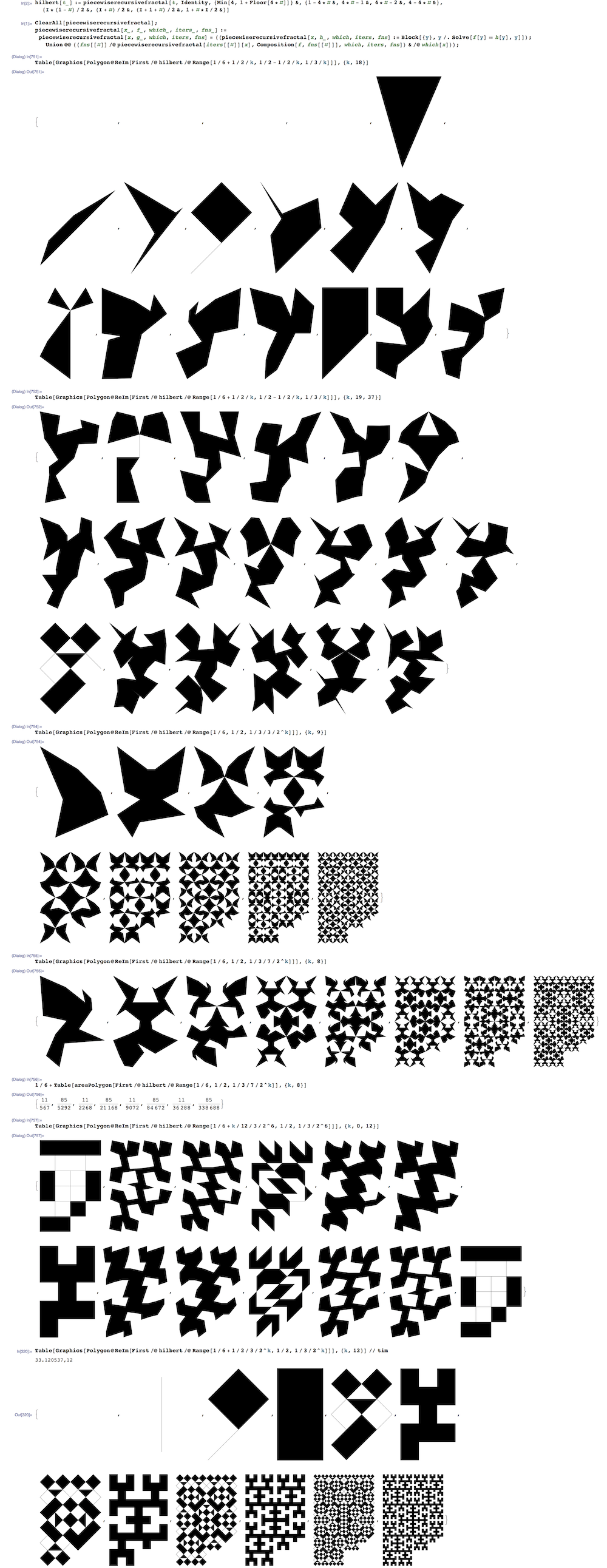Here is a function Julian Ziegler Hunts wrote to evaluate fractal curves at rational points and similarly recursively-defined functions. Usually dragon curves, Hilbert curves, etc. and their inverses.
ClearAll[piecewiserecursivefractal];
piecewiserecursivefractal[x_, f_, which_, iters_, fns_] :=
piecewiserecursivefractal[x, g_, which, iters,
fns] = ((piecewiserecursivefractal[x, h_, which, iters, fns] :=
Block[{y}, y /. Solve[f[y] == h[y], y]]);
Union @@ ((fns[[#]] /@
piecewiserecursivefractal[iters[[#]][x],
Composition[f, fns[[#]]], which, iters, fns]) & /@ which[x]));
But most remarkable is piecewiserecursivefractal ability to invert fractals--e.g., tell you all the pre-images of a point near or on the "Dragon Curve". Imagine writing a function that can even tell whether some point is inside or outside that infinitely curly boundary. If we define trifil as the usual recursive quadrisection:
Clear@trifil;
trifil[t_] := piecewiserecursivefractal[t,
Identity, {Min[4, 1 + Floor[4*#]]} &, {4*# &, 2 - 4*# &, 4*# - 2 &,
4 - 4*# &}, {#/2 &, (#/I^(2/3) + I^(2/3))/2 &, (# + I^(2/3))/2 &,
1 + #*I^(4/3)/2 &}]
we can get a weird (slightly spazzed) triangle fill, which is an unsuccessful attempt at a space-fill with a sextuple point. But I expect to find one.
Graphics[Riffle[Hue /@ Range[0, 15/7, 1/7],
Line /@ mapthread[Append[#1, #2[[1]]] &, {#, Append[Rest[#], Last[#]]}] &@
Partition[ReIm@Flatten[trifil /@ Range[1/4096, 4095/4096, 1/2048]],128]]]
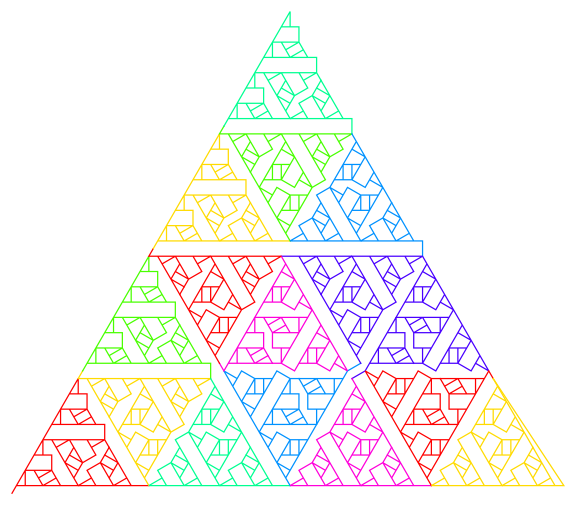
Using a 25-way conditional, Julian found a space-fill with sextuple points, as suggested by this schematic:
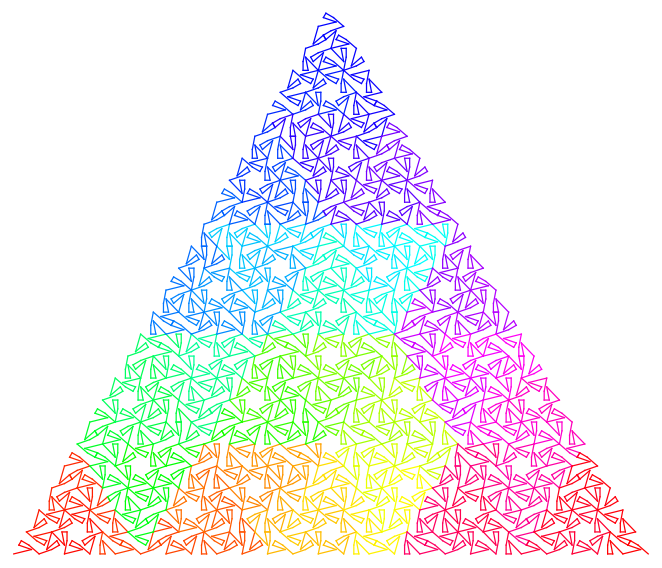
The confusing term "spacefilling curve" leads many to believe it means a diagram like this. This diagram is just a schematic for constructing a spacefilling function, a much more wonderful object that continuously maps closed intervals onto closed areas of the complex plane. A spacefilling function not only hits all the points in an area, it hits a dense subset of them at least three times. Julian's spacefill hits a dense set six times! And his piecewiserecursivefractal Mathematica function can find all six pre-images of each sextuple point:
untrifil25[1/2 + I Sqrt[3]/10]
Out[]= {8/75, 11/75, 14/75, 17/75, 4/15, 23/75}
where:
Clear@untrifil25;
untrifil25[t_] :=
piecewiserecursivefractal[t, Identity,
If[0 <= Re[#1] <= 1 && 0 <= Im[#1] <= Sqrt[3]/2, {1, 2, 3, 4, 5, 6,
7, 8, 9, 10, 11, 12, 13, 14, 15, 16, 17, 18, 19, 20, 21, 22, 23,
24, 25}, {}] &, {5 #1 &,
1/4 (6 - 2 I Sqrt[3] - 10 #1 + 10 I Sqrt[3] #1) &,
1/4 (-4 I Sqrt[3] + 10 #1 + 10 I Sqrt[3] #1) &, -2 + 5 #1 &,
1/4 (-6 + 6 I Sqrt[3] + 10 #1 - 10 I Sqrt[3] #1) &,
1/4 (4 + 8 I Sqrt[3] - 10 #1 - 10 I Sqrt[3] #1) &,
3 + I Sqrt[3] - 5 #1 &,
1/4 (10 - 2 I Sqrt[3] - 10 #1 + 10 I Sqrt[3] #1) &,
1/2 (3 + I Sqrt[3] - 10 #1) &,
1/4 (8 - 10 #1 + 10 I Sqrt[3] #1) &,
2 + I Sqrt[3] - 5 #1 &, -2 - I Sqrt[3] + 5 #1 &,
1/4 (4 - 8 I Sqrt[3] + 10 #1 + 10 I Sqrt[3] #1) &,
1/4 (-10 + 2 I Sqrt[3] + 10 #1 - 10 I Sqrt[3] #1) &,
1/4 (-2 + 6 I Sqrt[3] - 10 #1 - 10 I Sqrt[3] #1) &,
1/4 (16 - 10 #1 + 10 I Sqrt[3] #1) &, -2 - 2 I Sqrt[3] + 5 #1 &,
1/4 (-14 + 2 I Sqrt[3] + 10 #1 - 10 I Sqrt[3] #1) &,
1/2 (-3 I Sqrt[3] + 5 (-1 + 2 #1)) &,
1/4 (16 - 4 I Sqrt[3] - 10 #1 + 10 I Sqrt[3] #1) &,
4 + I Sqrt[3] - 5 #1 &,
1/4 (6 + 10 I Sqrt[3] - 10 #1 - 10 I Sqrt[3] #1) &,
1/2 (9 + I Sqrt[3] - 10 #1) &,
1/4 (8 + 8 I Sqrt[3] - 10 #1 - 10 I Sqrt[3] #1) &, -4 +
5 #1 &} /.
f : Function@_ :>
MapAt[Simplify, f, 1], {#1/25 &, (2 - #1)/25 &, (2 + #1)/
25 &, (3 + #1)/25 &, (4 + #1)/25 &, (5 + #1)/25 &, (6 + #1)/
25 &, (7 + #1)/25 &, (8 + #1)/25 &, (10 - #1)/25 &, (11 - #1)/
25 &, (11 + #1)/25 &, (13 - #1)/25 &, (14 - #1)/25 &, (14 + #1)/
25 &, (16 - #1)/25 &, (16 + #1)/25 &, (18 - #1)/25 &, (18 + #1)/
25 &, (19 + #1)/25 &, (21 - #1)/25 &, (22 - #1)/25 &, (22 + #1)/
25 &, (24 - #1)/25 &, (24 + #1)/25 &}]
The image of [2/25,8/25] fills a hexagon:
Graphics[Polygon[ReIm[trifil25 /@ Range[2/25, 8/25 - 1/3125, 1/3125]]]]
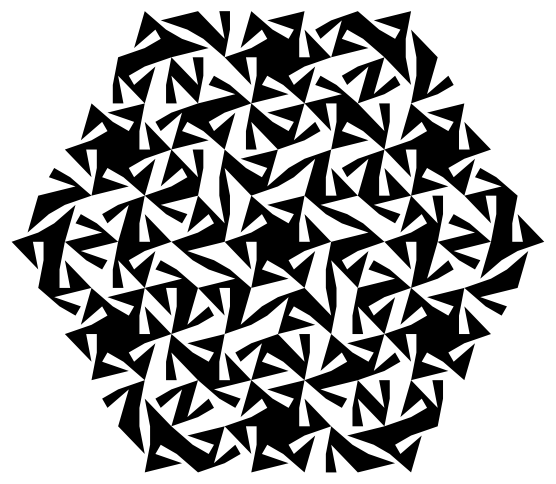
where:
Clear@trifil25;
trifil25[t_] :=
piecewiserecursivefractal[t, Identity,
Piecewise[{{{1}, #1 == 0}, {{Ceiling[25*#1]},
Inequality[0, Less, #1, LessEqual, 1]}}, {}] &, {25*#1 +
0 &, -25*#1 + 2 &, 25*#1 - 2 &, 25*#1 - 3 &, 25*#1 - 4 &,
25*#1 - 5 &, 25*#1 - 6 &, 25*#1 - 7 &,
25*#1 - 8 &, -25*#1 + 10 &, -25*#1 + 11 &,
25*#1 - 11 &, -25*#1 + 13 &, -25*#1 + 14 &,
25*#1 - 14 &, -25*#1 + 16 &, 25*#1 - 16 &, -25*#1 + 18 &,
25*#1 - 18 &, 25*#1 - 19 &, -25*#1 + 21 &, -25*#1 + 22 &,
25*#1 - 22 &, -25*#1 + 24 &,
25*#1 - 24 &}, {#1/
5 &, (1/10)*(3 + I*Sqrt[3] + (-1 - I*Sqrt[3])*#1) &, (1/
10)*(3 + I*Sqrt[3] + #1 - I*Sqrt[3]*#1) &, (2 + #1)/
5 &, (1/10)*(6 + #1 + I*Sqrt[3]*#1) &, (1/10)*(7 + I*Sqrt[3] +
I*(I + Sqrt[3])*#1) &, (1/5)*(3 + I*Sqrt[3] - #1) &, (1/
10)*(4 + 2*I*Sqrt[3] + (-1 - I*Sqrt[3])*#1) &, (1/10)*(3 +
I*Sqrt[3] - 2*#1) &, (-(1/10))*
I*(-I + Sqrt[3])*(-2 + #1) &, (1/5)*(2 + I*Sqrt[3] - #1) &, (1/
5)*(2 + I*Sqrt[3] + #1) &, (1/10)*(5 + 3*I*Sqrt[3] + #1 -
I*Sqrt[3]*#1) &, (1/10)*(4 + 2*I*Sqrt[3] + #1 +
I*Sqrt[3]*#1) &, (1/10)*(4 + 2*I*Sqrt[3] +
I*(I + Sqrt[3])*#1) &, (-(1/10))*
I*(-I + Sqrt[3])*(-4 + #1) &, (1/5)*(2 +
2*I*Sqrt[3] + #1) &, (1/10)*(5 + 3*I*Sqrt[3] + #1 +
I*Sqrt[3]*#1) &, (1/10)*(5 + 3*I*Sqrt[3] + 2*#1) &, (1/
10)*(7 + 3*I*Sqrt[3] + (-1 - I*Sqrt[3])*#1) &, (1/5)*(4 +
I*Sqrt[3] - #1) &, (1/10)*(9 + I*Sqrt[3] +
I*(I + Sqrt[3])*#1) &, (1/10)*(9 + I*Sqrt[3] - 2*#1) &, (1/
10)*(8 + I*(I + Sqrt[3])*#1) &, (4 + #1)/5 &} /.
f : (_ &) :> MapAt[Simplify, f, 1]][[1]]
?Sextuple points:
In[35]:= trifil25[4/15]
Out[35]= 1/10 (5 + I Sqrt[3])
In[36]:= untrifil25[%/5]
Out[36]= {8/1875, 11/1875, 14/1875, 17/1875, 4/375, 23/1875}
Near 1/?:
In[37]:= trifil25[113/355]
Out[37]= (7 (291312775 + 106362056 I Sqrt[3]))/6105469375
In[38]:= untrifil25@%
Out[38]= {113/355}
Here's a sampling with small dinosaurs surrounding a ghostly hexagon at an odd angle:

Here are some beat frequency effects:

And a remarkably celebratory finale:
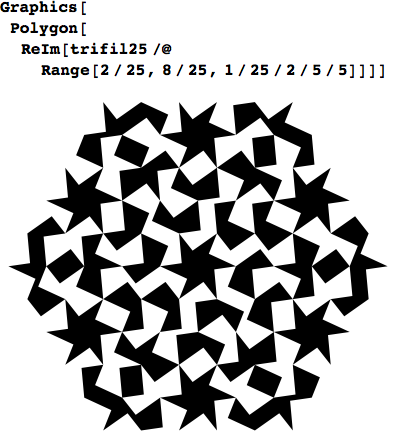
Attached is also an example where piecewiserecursivefractal defines the Hilbert space-fill, (t:[0,1]->[0,1]×[0,i] which encloses the upper left and ? of the lower left quadrants as 1/6?t?1/2. The pictures are "connect-the-dots" of exact values along the space-fill, sampled at various fixed phases and frequencies.
